I met this great bloke, Ross Lillistone, a classy sailor, designer, and builder of boats, at a boat show in 2005 and asked him to sell me plans and give me guidance in the selecting and building of a couple of small boats—a 9′ Sherpa that I rigged with a balanced lugsail and 10′ Fish Hook rowing boat—both from designer John Welsford. I’d been happily sailing then with a new cohort of like-minded sailors, but I eventually realized that I needed a faster, more versatile, but still simply rigged boat. I didn’t have the time to embark on building a third, so I was hoping Ross could both design and build a boat for me, and in 2007 he said he could.
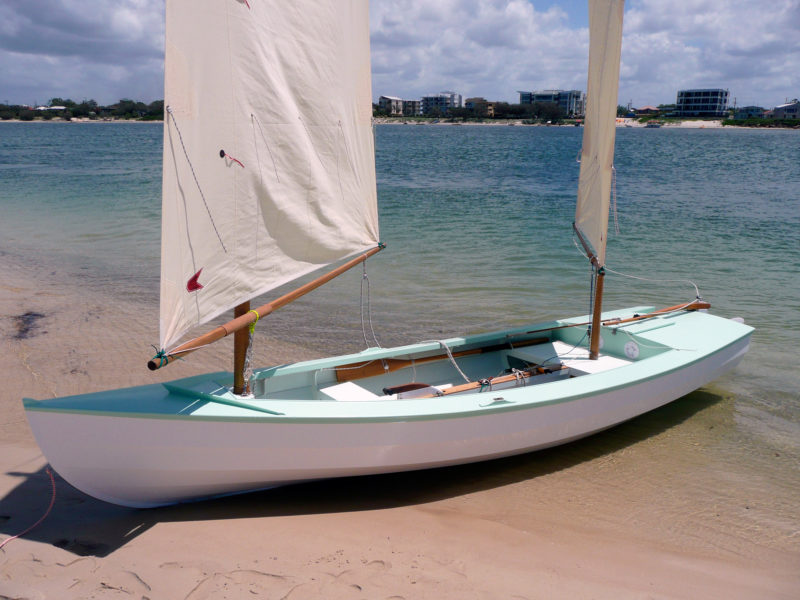 John Shrapnel
John ShrapnelThe two masts fit all three of the mast steps, providing the option to sail with both sails, the main alone, or the mizzen alone, as conditions require.
He got to work drawing a larger, faster, but still simply rigged and sailed camp-cruiser with rowing and motor backup. He came up with a new design, and in 2008 a beautifully built 17′ cat-ketch with balanced lugsails emerged from his shop. I christened the boat PERIWINKLE, and Ross adopted the name for the design.
The Periwinkle has a glued 9mm-marine-plywood lapstrake hull with five strakes, built on its frames and bulkheads over a strongback. It has hardwood gunwales, stem, and skeg. It has very large and accessible flotation compartments, the rear one (capable of huge gear stowage) reached from a large midline hatch. The boat and sailing rig take about 600 hours to build.
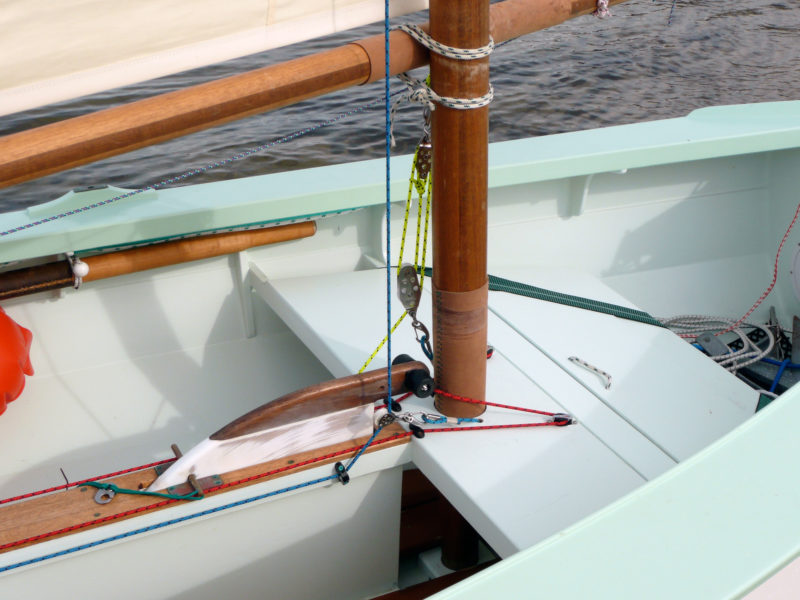 John Shrapnel
John ShrapnelThe center mast partner braces the forward end of the centerboard trunk. The mast’s leather is long enough to protect the the mast in either of the partners it can be placed in.
Periwinkle has three maststeps, two for the main and one for the mizzen, giving many options for sail configuration. Ross built a beautiful bird’s-mouth mainmast, light enough to lift and drop into the appropriate mast step. Each mast, bundled with its spars and sail, fits within the boat’s length for storage and trailering.
I usually sail solo and enjoy that most but sailing with two or three aboard also works well. Being such a light boat, it is very easy to launch and retrieve singlehandedly. The lug sails and unstayed masts make for extra quick rigging at the ramp. For camp-cruising or daysailing in tidal waters, I carry two inflatable beach rollers. They make it easy to move the boat across any expanses of sand. Fully inflated, they stow neatly under each of the side decks along with the oars. If I’m daysailing from a beach camp, the simplicity of just pulling up the main, dropping the rudder and centerboard, and sailing away are always appreciated.
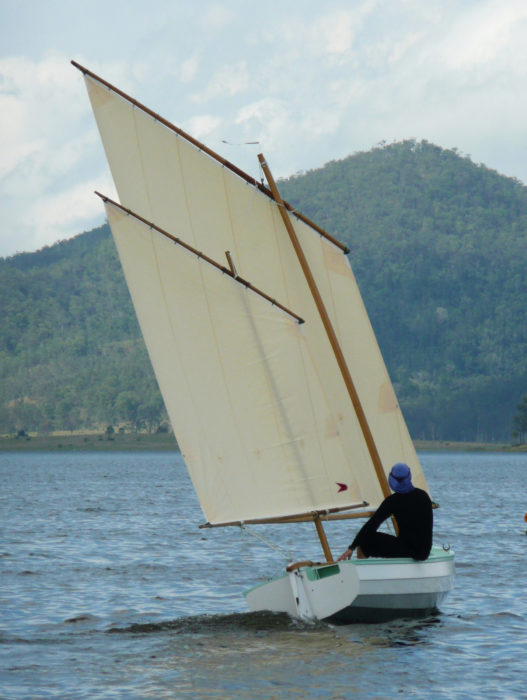 Paul Hernes
Paul HernesWhen fully set, the lug cat-ketch rig carries 156 sq ft of sail.
The Periwinkle excels in light air, and is a fast and easily driven boat, leaping forward in response to any puff of wind. Its initial tenderness is followed by stiffness as the aft sections come into play. With the full cat-ketch rig, I take to the ample side-decks early on to maintain the trim. An extra crew can help but is not necessary. If I’m sailing solo with the full rig I put the first reefs in at 7 to 10 knots of wind.
The rear seating, situated just forward of the rear deck, places the helmsman optimally for weight distribution. It is very comfortable tucked into those back corners with a leg resting on the seat and a foot wedged against the other side. Likewise, if hiking outboard on the side decks with tiller extension, your feet push firmly against the centerboard trunk as a counter to your pull on the mainsheet. When I spend the night aboard the boat, the floorboards offer enough room for comfortable sleeping to either side of the trunk.
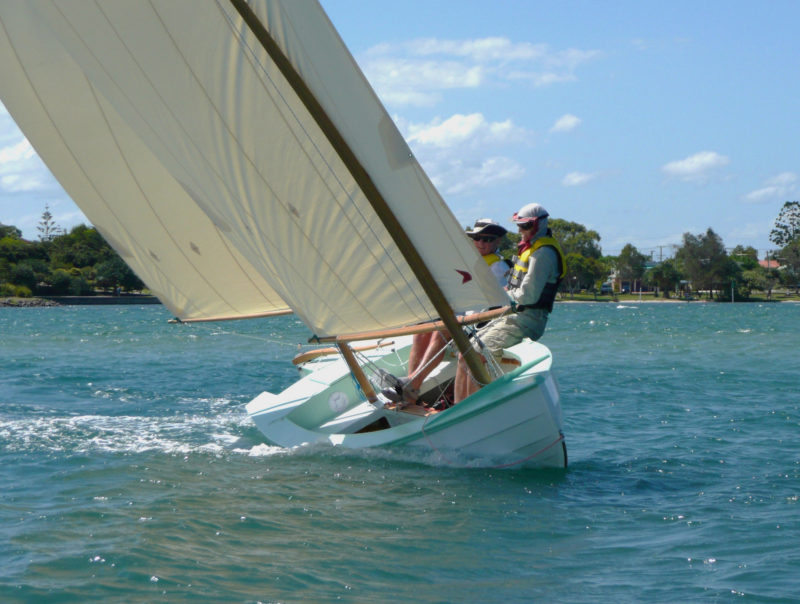 Paul Hernes
Paul HernesThe centerboard trunk makes a good footrest for the crew while they’re sitting on the rail.
Under sail, the Periwinkle points high, especially trimmed so the transom just kisses the water while the forefoot is well in—it helps to edge the bow upwind as it peels the water away. The fine entry means minimal hobby-horsing to impede its progress through choppy water. The boat is generally a very dry ride.
The Periwinkle has an ample skeg, so on every point of sail but tight push to windward using a small amount of centerboard to counter leeway. Minimal use of the centerboard, of course, helps speed. The hull has such a shallow draft that with board almost up it will get across any bit of shallow water, even as little as 6”.
When tacking, the Periwinkle doesn’t snap about like some of the other boats, probably because the centerboard acts like a long keel when it’s only partially deployed. Fully lowering the board to a nearly vertical position would make it easier for the boat to pivot around it.
Sailing on a run in stronger winds with lug sails requires care and attention. The yard shouldn’t be let out to more than 90 degrees, as dreaded rolling may put you in the drink. I learned this lesson the hard way.
And if you do capsize? The Periwinkle won’t put its mast under, so the hull will lie on its side, supported by both the mast and the watertight compartments in the ends. It was easy for me to get on the centerboard to right the boat, then slip in over the side. The built-in buoyancy limits the water scooped up, and a large bucket works well to clear the cockpit. I’ve thought an electric bilge pump would be a good addition.
I once capsized to starboard while my motor was clamped on the transom, and though it was partly dunked, I had the boat up so quickly that the motor was fine and started straight away. The air intake must have been clear of the water or perhaps there was a good seal on the cover. A capsize to port would leave the outboard well completely above water.
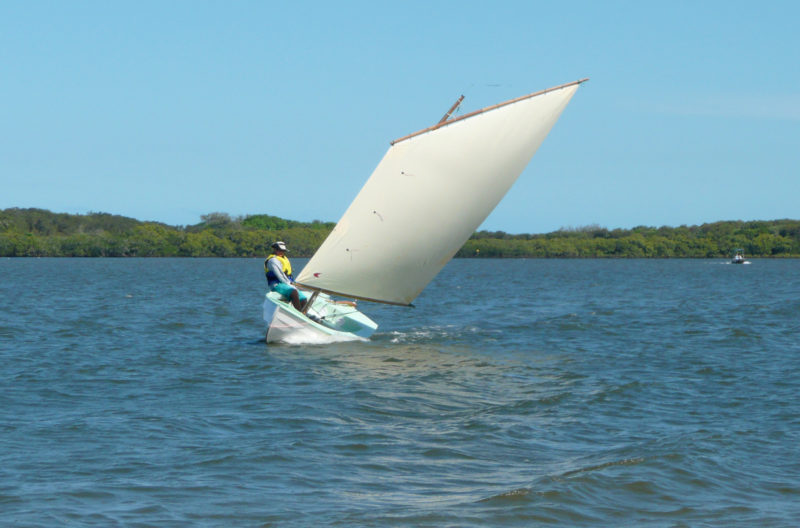 Paul Hernes
Paul HernesWith the lug-rigged ketch setting only the 105 sq ft main in the middle partner, the Periwinkle still makes good speed and simplifies sail-tending tasks for the skipper.
I’ve tried all of the options the cat-ketch rig offers for sail area; the variety provides flexibility for various wind speeds. The least sail area is under the mizzen alone, and the boat really sings along in 15 to 20 knots of wind while I stay comfortably seated inboard. The helm is better balanced while using two sails, or when using one by adjusting the mainsheet and centerboard and the fore-and-aft trim. A light touch on the tiller is the reward. When tacking, moving around the centerboard case (which extends to the thwart in front of the mizzen mast) was awkward at first, but I’ve learned how to execute a flowing crossover.
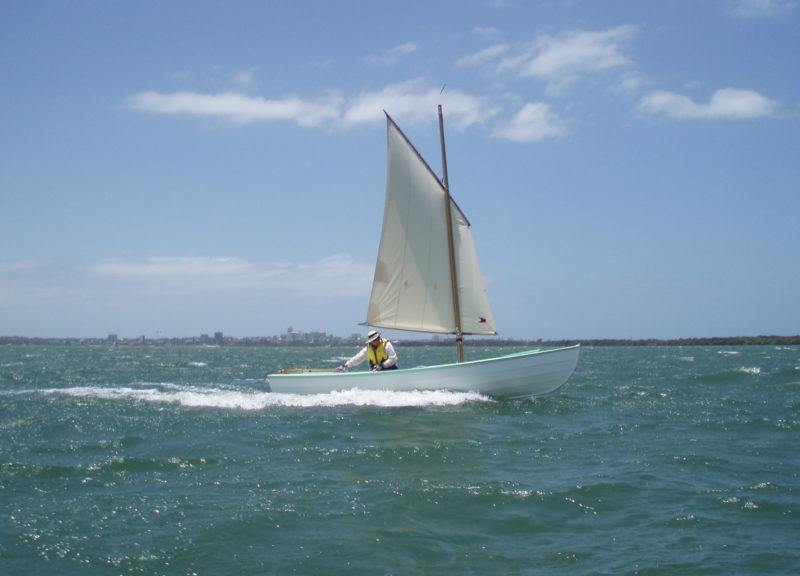 John Shrapnel
John ShrapnelIn a fresh breeze, with the mizzen set in the middle partner, the Periwinkle made a GPS-measured 7 knots.
I have all the sail and centerboard controls led to the helm. If the wind is up, I can also reef both the main and mizzen from there. The yards on both sails drop readily when rounded up to the wind when their halyards are eased. If I know I’ll have brisk sailing conditions, I’ll fix about 25 lbs of lead below the floorboards, each side of the centerboard trunk. The additional weight improves performance and comfort.
As my experience with the boat grows, I have found a wonderful rig setup that’s not among those in Ross’s drawings. I step the mainmast in the forward position and move the downhaul forward to the tip of the boom, reconfiguring the balanced lug into a standing lug. This puts the aftmost part of the boom forward and well above head height—a very comforting modification. She looks good too, and still points high with great speed. As I get older and less energetic, I find this is now the optimal rig for me.
Ross kept rowing in mind when he designed the Periwinkle; the thwart and rowlocks are well situated for solo rowing. I leave the rudder hung on the transom and use a tiller tamer, as the tiller is out of reach. With a good pair of oars, the Periwinkle glides along straight and true.
For motoring I have a 2.5-hp four-stroke outboard. I fix the motor to straight ahead and use the rudder and tiller for directional control. It’s a long reach to the motor over the rear deck, so I have a small pole with loop of line for shifting gears and an extension on the throttle control. The motor well is offset to starboard, but it still keeps the motor above the water when the boat is strongly heeled on a port tack. Under power, the Periwinkle achieves hull speed at an economical half throttle.
The Periwinkle is a fine and versatile boat, and can be customized for a wide array of requirements. I’ve enjoyed the exploration of sail options and efficiency and simplicity of the lugsails. (Ross includes gaff-headed cat rig with flying jib option in his plans.)
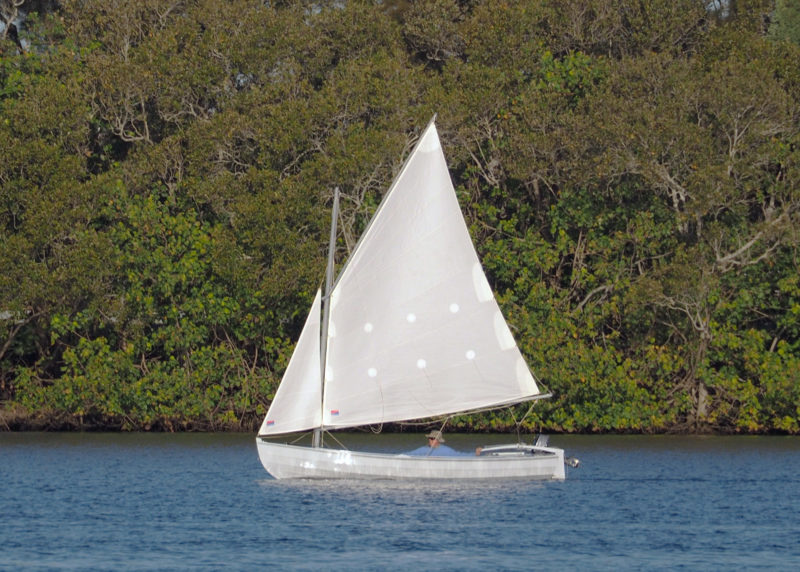 Ross Lillistone
Ross LillistoneThis Periwinkle carries the gaff cat with jib rig with a total of 132 sq ft of sail.
In its full rig option, the Periwinkle may not be a boat for a novice sailor, but with a reduced rig it offers easy and safe sailing. For those with more experience, a competitive streak, and an inquisitive mind, the Periwinkle gives a rewarding sail. I never stop learning about this boat and its abilities, and as I get older, my appreciation grows for the many options for reducing sail while maintaining performance.
We old sailors are a very competitive bunch, and all of us love our own boats. We constantly tune them to eke out every bit of speed as we close on the boat ahead (or to avoid getting closed-in on) and chuckle to see the other skipper furtively checking his trim, centerboard, and sail settings, trying to look unconcerned at being outfooted.
So, is the Periwinkle a good performer? Well, it really suits and satisfies me, and is a great all-rounder. It has taught me plenty about sailing.![]()
John Shrapnel, a retired anesthesiologist, and his family live mostly in Queensland, on Australia’s Sunshine Coast. He has sailed enthusiastically for 10 years or so with a group of disparate older fellows in their home-built small wooden boats from designers all over the world. They often gather for meetings convened by the Wooden Boat Association of Queensland (WBAQ), whose members include boatbuilders and sailors from amateurs to masters. John has always lived by the sea, and boatbuilding, sailing, and the companionship afforded by the small-boat community are integral parts of his happy retirement.
Periwinkle Particulars
[table]
Length/17’2″
Beam/5’2″
Displacement, salt water/877 lbs
Sail area, Lug cat-ketch/156 sq ft
Sail area, gaff sloop/132 sq ft
[/table]
Plans for the Periwinkle are available from Ross Lillistone’s web site printed ($180 AUD, approx. $133 USD) or as PDF files ($170 AUD, approx. $126 USD).
Is there a boat you’d like to know more about? Have you built one that you think other Small Boats Monthly readers would enjoy? Please email us!
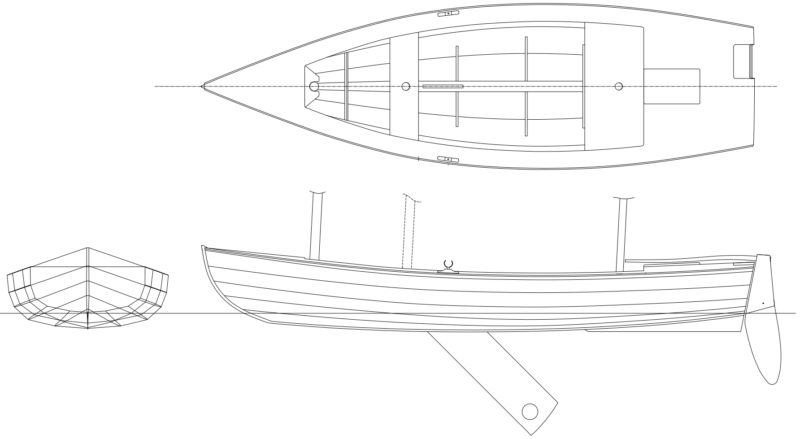
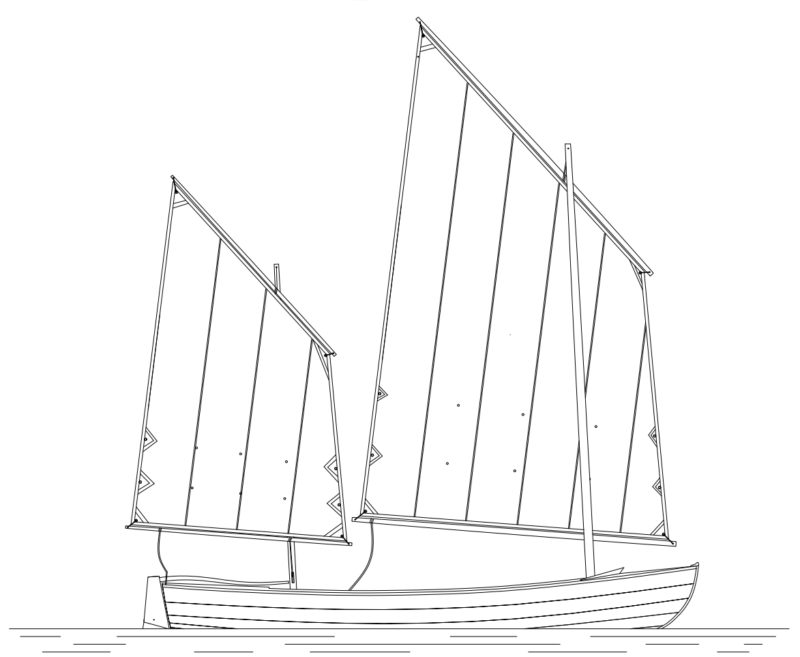
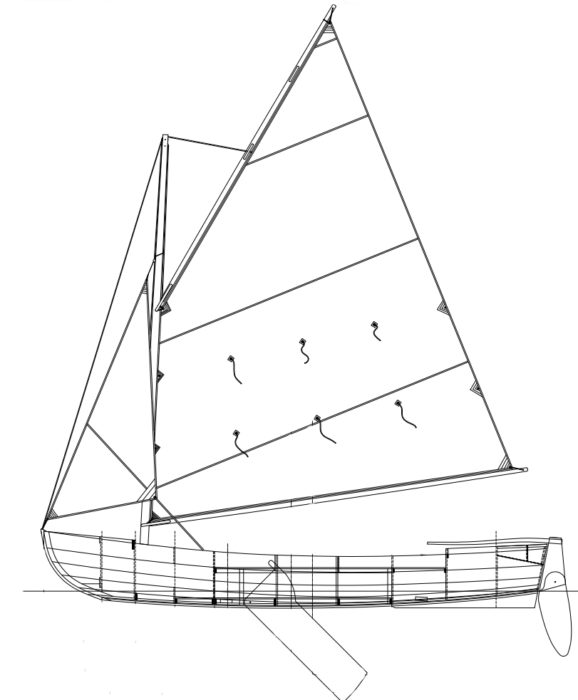
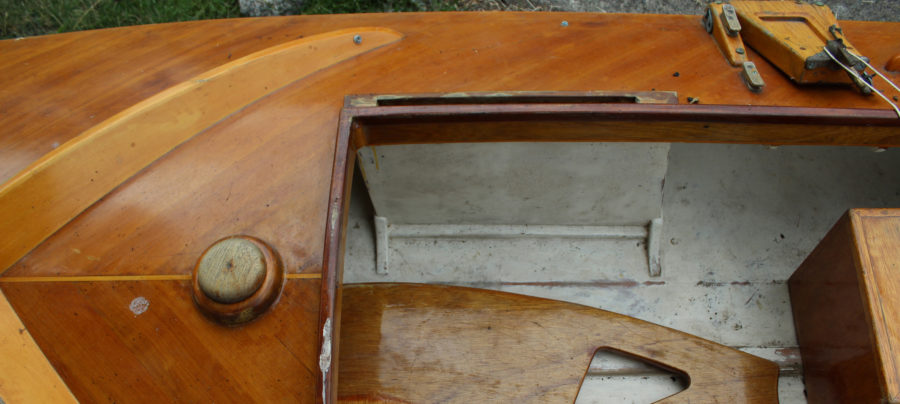
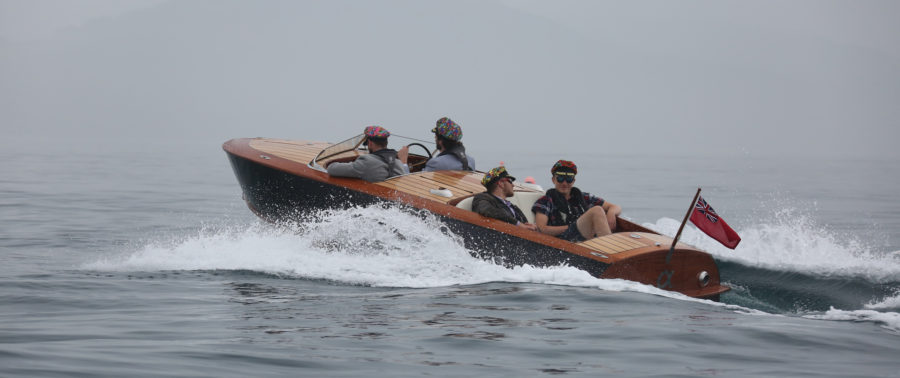
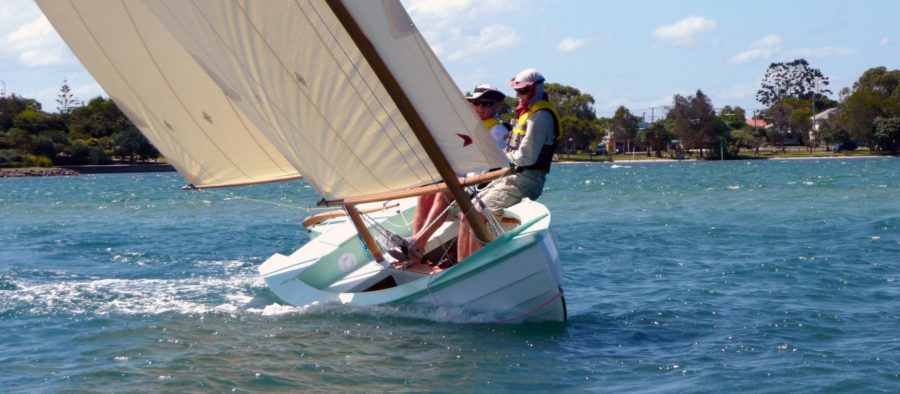

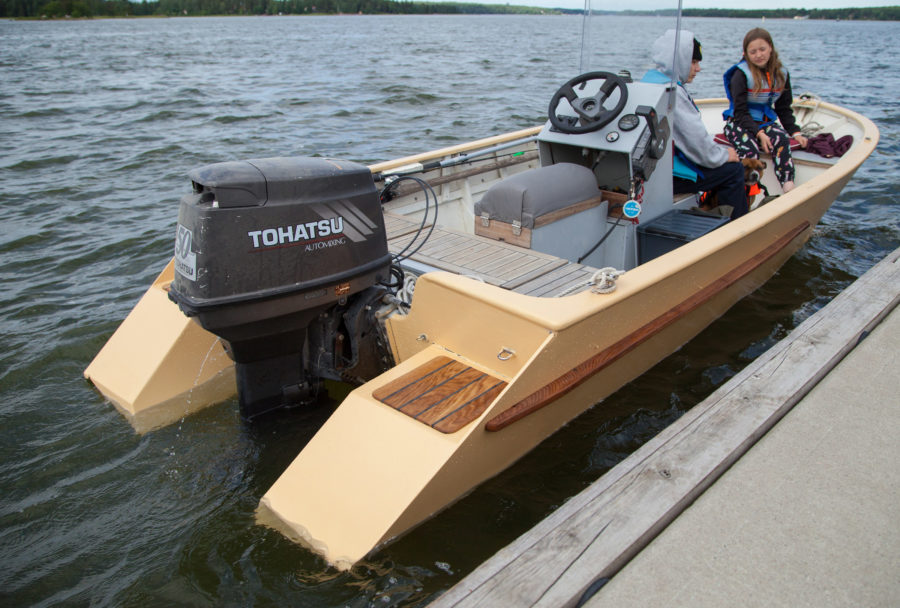
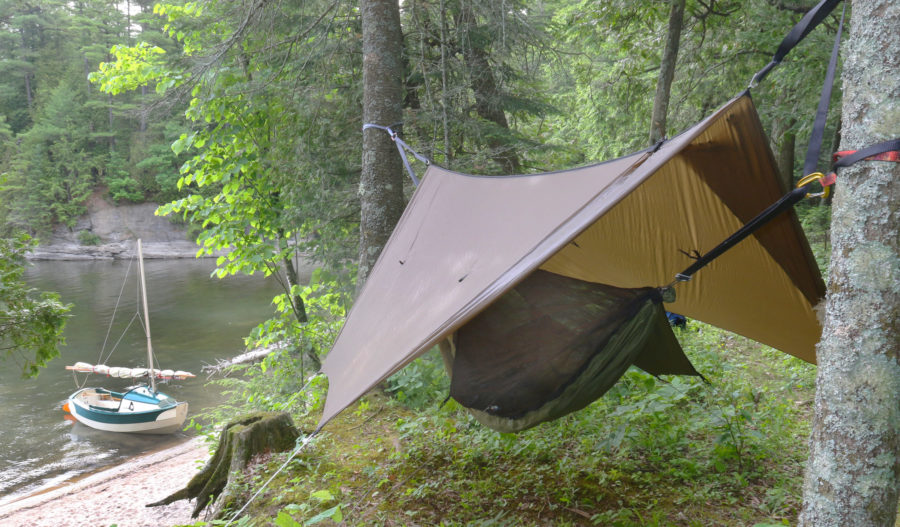
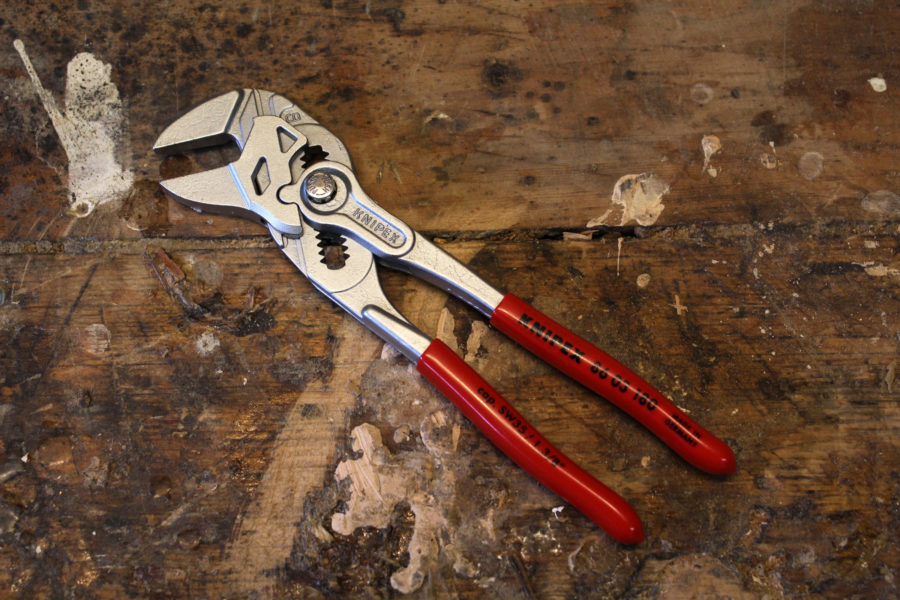
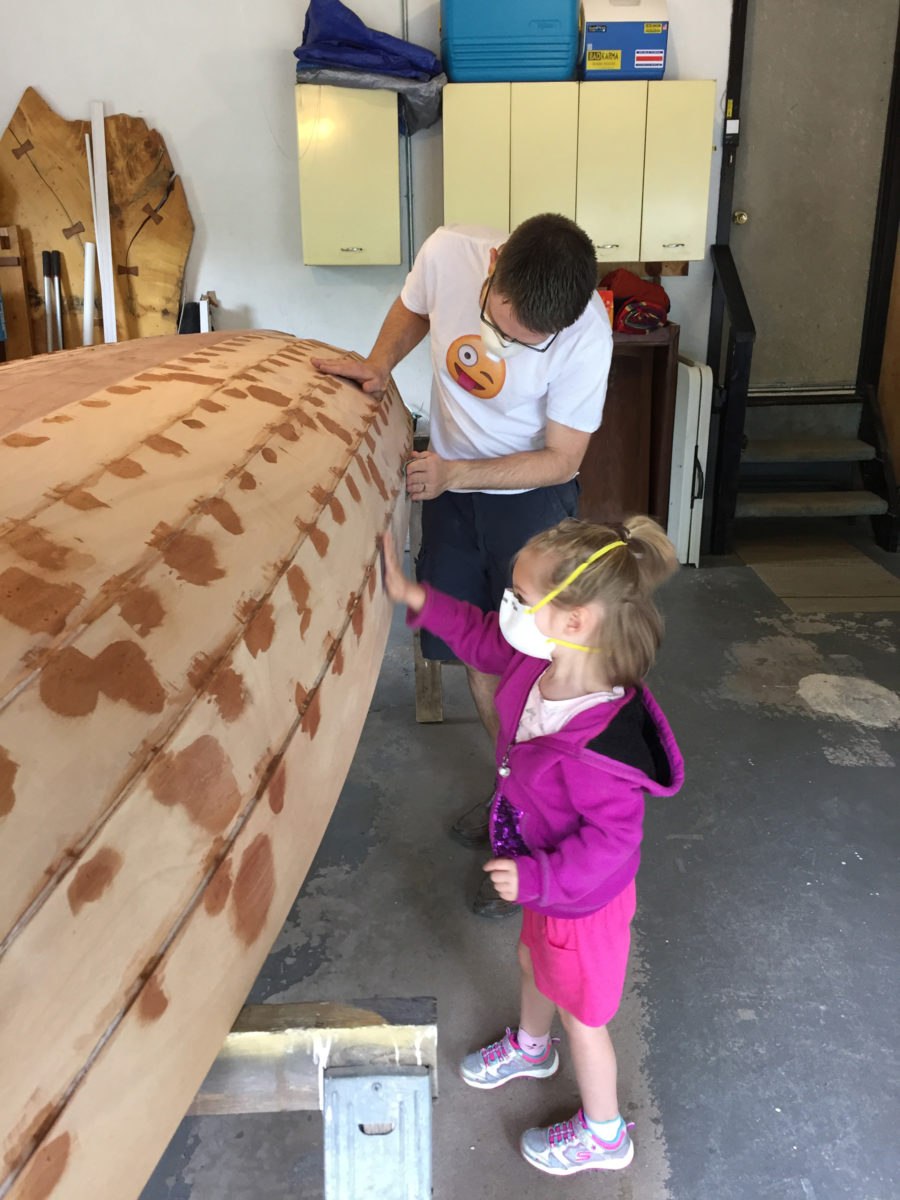
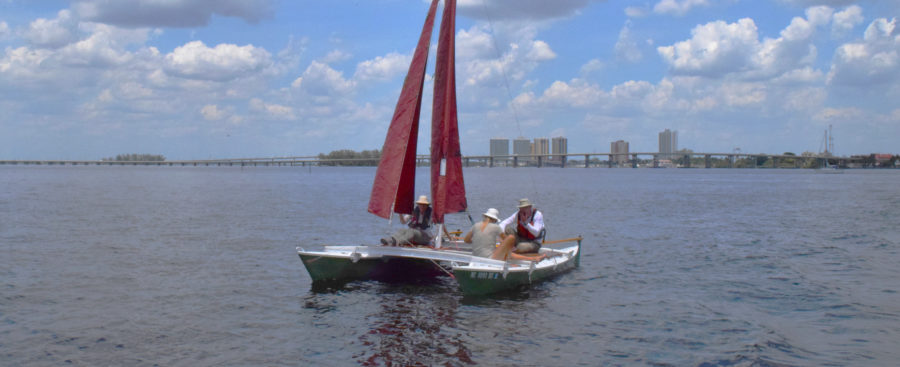
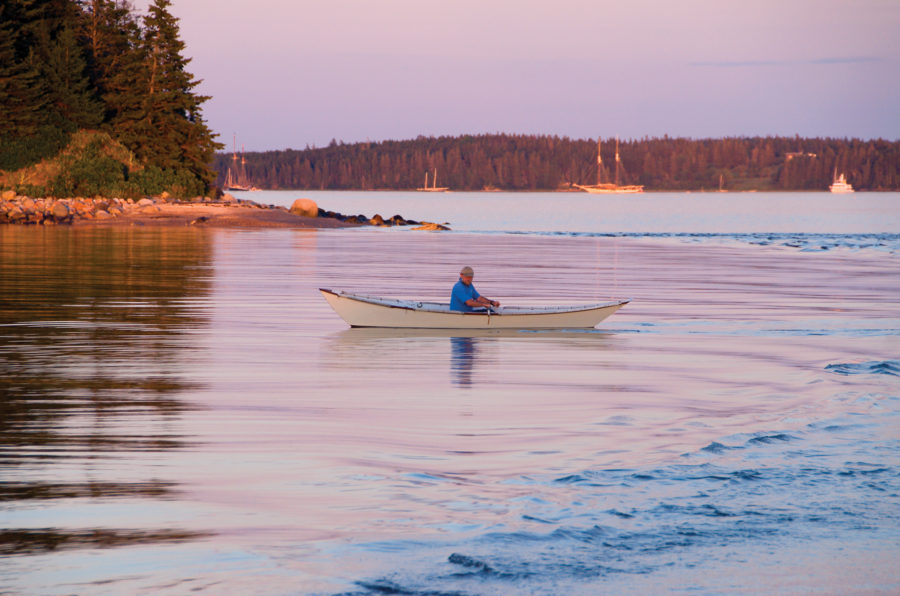
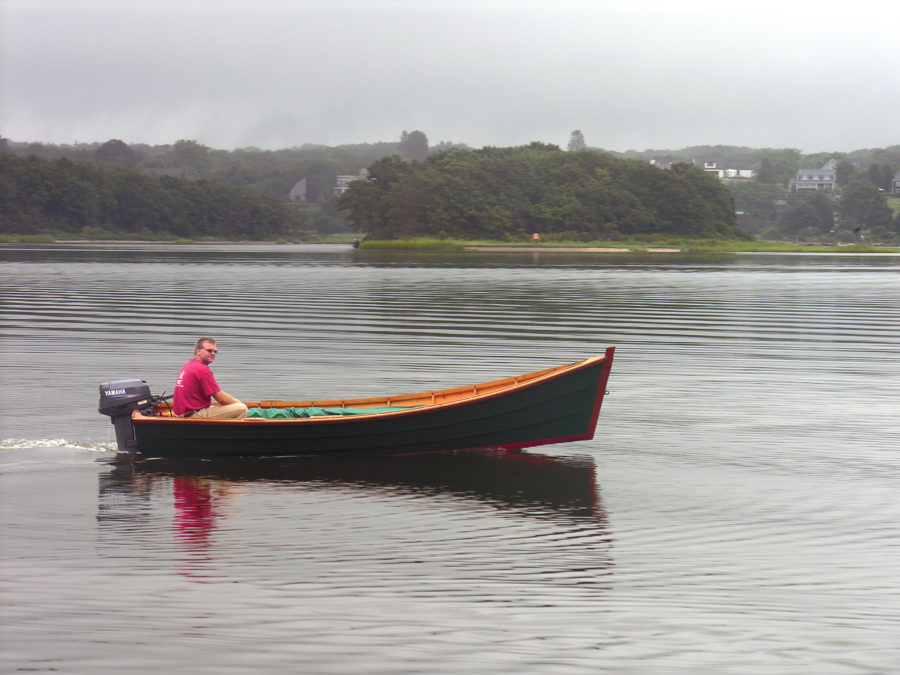
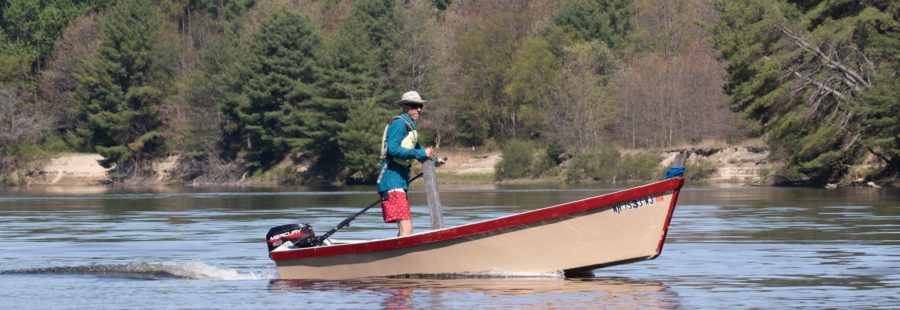
Nice looking craft. I particularly like the gaff ketch rig setup. That looks easy to handle but still capable of giving a rattling good sail.
Beautiful lines and nicely balanced. Looks fast and sturdy.
Enjoyed reading the article.
So many options. Nice not being stuck with one configuration if you’re a newbie sailor and not sure what you might lik or not. And yeah, that would be me.
I thought it might be worth adding these two clips here. One shows the Periwinkle with standard cat ketch rig in light air, and the other with rig set as standing lug, (as per my mentioned preferred option currently) nicely pacing a reefed Fulmar with both speed
and windward ability.
https://www.youtube.com/watch?v=mazM15TACjc
https://www.youtube.com/watch?v=82uRdBJmqdg
I love the paint job–what is the color name and brand of the aqua-ish paint for the gunwales and interior?